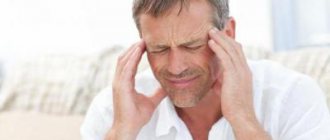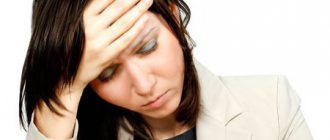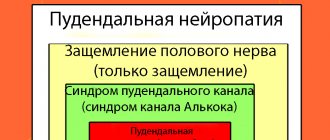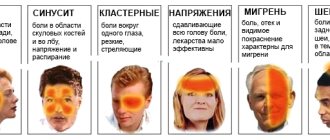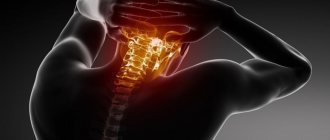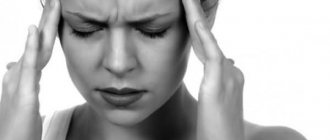Our expert is Candidate of Medical Sciences, neurologist, associate professor of the Department of Fundamental Clinical Neurology of the Russian State Medical University Irma Shetova.
Almost every man considers women’s complaints of headaches to be a typical “excuse” that helps women avoid household chores, unpleasant conversations or marital duties. If only our other halves knew how unfair they are to us! Scientists have proven that women suffer from migraines three times more often than men!
Secondary headache
Based on the name, it is clear that the initiator is in a different place, and discomfort in the head is only a secondary sign, like an alarm that indicates that there are some disturbances in the body. There can be a great variety of causes of secondary pain; identifying the organ in which the primary source of the disorder is located often requires complex and lengthy diagnostics, but the most common root causes are identified:
- Various viral infections
- Minor traumatic brain injuries left unattended
- Inflammation in the brain
- Hypertension, vascular diseases
- Various tumors
- Osteochondrosis
- State of pregnancy or menopause
You can more accurately determine the source of the primary disorder by observing the body's reaction to the following stimuli: the presence of acute reactions to bright light and loud sounds, the urge to nausea and vomiting, sudden chills, dizziness.
Primary headaches
In contrast to secondary, primary are those whose primary source is the human head itself. In what follows, we will keep in mind precisely this type of pain that arises.
Some doctors admit that the appearance of headaches in women, especially after 30-40 years, up to two times a week may be the norm, but living in this regime is difficult and uncomfortable. More frequent pain syndrome will clearly indicate the presence of some pathologies that require attention and treatment.
In general, women's headaches, if we do not take into account situations of pregnancy, menopause, menstruation and other issues associated with hormonal and physical disruptions, are equally characteristic of different age groups, both at the age of 25-30 years, and 40-50 and over 55 years
In general, a headache appears due to overwork; to eliminate it, you need to relax and rest for several hours. In addition, the source may be constant disruption of the daily routine, anxiety, stress, anxiety, lack of sleep, mental overstrain due to prolonged work at the computer. Women are more emotional than men, they perceive what is happening around them more closely, which further aggravates the process of development of pathology, leading to constant or frequent occurrence of pain in the head.
Constant consumption of strong coffee and alcoholic beverages can lead to frequent headaches.
One-time reasons may be weather changes, when atmospheric pressure changes sharply in one direction or another, which affects a person’s blood pressure.
Weakness of the weaker sex
| Medicines have a way of taking revenge. | |
| It is estimated that a person who does not treat migraines loses about three years of active time in their lifetime. Still, it is better not to abuse painkillers. After all, this can cause a new type of illness - drug headache. This is especially true for products containing metamizole sodium, which negatively affect liver function and the hematopoietic system, so their use is limited in many countries of the world (Denmark, Italy, Germany, Great Britain, USA, Australia, etc.). | |
It is believed that every fourth woman is familiar with this disease. And no matter what men grumble about notorious simulators, we have strong physiological grounds to assert that our lot is much heavier than men’s. The main thing is that women have a lower pain threshold. And although we ourselves have long been accustomed to thinking differently, you cannot fool science: it has been experimentally proven that nature has made us more sensitive to pain. It's just that ladies are more patient, that's why there is such confusion.
The second factor is scarcity. Sadly, the female brain contains less of the neurohormone serotonin, which is also called the hormone of joy. This explains the fact that it is the fair half of humanity that most often suffers from depression. And recently it turned out that serotonin also has pain-relieving properties. And, since we lack this substance, here is the result!
But that's not all. The main contribution was made by female sex hormones. It is known that before puberty, boys and girls suffer from headaches approximately equally, but as soon as hormonal changes occur in both, the picture changes dramatically. From this moment and for many years to come, many girls become hostage to migraines. So, it would be nice if our dear men did not hesitate to show sympathy for their other halves and did not forget to make allowances for the fact that we really are the weaker sex!
Migraine is a genetic disease and is often inherited (usually from the mother's side). Alas, it is impossible to completely get rid of this disease, but thanks to adequate treatment, the number and aggressiveness of its attacks can be reduced. But first you need to find out if it's a migraine.
How to understand pathology and one-time headache?
In order to understand whether there is a pathology or not, it is necessary to observe the following factors:
- In what part of the head is the source of pain located?
- How often does it occur, what is the frequency?
- With what intensity and duration is it present?
- Reasons why the pain recedes or subsides significantly
- Any other factors
If the presented data cannot determine the cause, then you need to consult a general practitioner who will prescribe a series of examinations:
- Electroencephalogram (EEG) of the brain, the procedure consists of reading the biocurrents of the brain, due to which changes in blood vessels are monitored, inflammatory processes, tumors and other abnormalities are monitored.
- Ultrasound . An examination of the condition of the vessels of the head and cervical region is carried out. Using ultrasound, you can identify diseases of the spine that complicate the functioning of the brain and cause pain.
- Magnetic resonance imaging (MRI) can detect even minor changes and abnormalities in the tissues of the head and brain
If even after the above studies no significant disturbances are revealed, then most likely the pain in the head is secondary. In this case, an examination and consultation with a wide range of doctors is required, including an ENT specialist, an ophthalmologist, a surgeon, and a dentist.
Beam (cluster) pain
Description.
One of the rarest, but at the same time the most painful types of headaches. Men aged 20-40 suffer more, but women under certain conditions are also at risk. Characterized by suddenness and sharpness. It can even wake a person up at night. Always develops on one side, concentrated in the area of the eyeball. It feels like they are trying to drill with a drill. Swelling, lacrimation, and blocked sinuses occur. A person cannot lie down or sit.
Causes.
The nature of cluster pain has not yet been studied. However, doctors consider alcohol and smoking to be the main provoking factors.
What to do?
Analgesics are powerless here. This is the case when you need to see a doctor. Your doctor will likely prescribe specialized treatment for you. For example, oxygen inhalations and injections such as Sumatriptan, which is considered the standard in the treatment of headaches. Also, to prevent attacks, a course of preventive medications may be prescribed, which will need to be taken periodically.
Forms of headaches
There are four forms of headaches. Depending on the form, it is possible to make one or another diagnosis about the causes and methods of disposal.
- Migraine, this form of pain has neurological roots, is periodic, usually occurring several times a month or less often
- “Pain of tension”, common among the fair half of humanity, depends on psychological stress
- Chronic, frequency of occurrence a couple of times a month
- Cluster, lasts from one hour to several days, is characterized as strong and painful, disrupting the usual course of life
Women often tend to exaggerate certain manifestations of pain and immediately go to the doctor. Therefore, if the pain is one-time in nature, or occurs as a result of obvious violations of the work and rest regime, then you just need to bring the regime back to normal and not panic ahead of time.
Factor in love, diet and lifestyle
Add to the list of hormonal causes of headaches stress, work overload, love experiences and noisy alcoholic hen parties on Fridays.
And don’t forget about diets - hunger and dietary restrictions can even lead to an escalation of a migraine to the point of fainting. And office employees often develop cervical osteochondrosis, the main symptom of which is an increasing headache. Why you are suffering from attacks must be determined. The method of treatment depends on this. For example, if the malaise is caused by low blood pressure, you will have to select medications with caffeine. And if you are hypertensive, the opposite approach is required. What are the main types of headaches, why do they occur and how to eliminate them?
How can a woman get rid of a headache?
Methods for reducing headaches in women do not differ from the generally accepted ones. For different types of headaches, you can take different painkillers. In general, the goal of a painkiller is simply to relieve pain until the pain ceases to appear. Typically, the “head pill” begins to act within 40-90 minutes after administration, so to relieve symptoms, you must take the medicine as soon as the first signs appear. In the case of non-chronic pain caused by overwork, weather or other factors, aspirin, ibuprofen and similar medications provide good relief from painful discomfort in the head. When treating with tablets, you must adhere to several rules:
- Take pills without a doctor’s prescription only once , and under no circumstances take them every day, so as not to develop psychological dependence when it seems that without the pill your head will hurt again. This can only worsen the condition.
- If you need a painkiller more than 3-4 times a week, then this is a reason to consult a doctor , since this situation cannot be considered the norm. In the case of systematic medication use, the body loses the habit of relying only on its own strength.
- If you realize that you are taking pills for headache pain too often , then you should immediately stop taking it and consult a therapist.
Side effect of Botox
To humbly endure spasms that split your head in half, without resorting to painkillers, is pure masochism. Yes, this is harmful. Therefore, it is better not to wait until the pain makes you, like Pontius Pilate, “cowardly think about poison,” but immediately, as soon as a “migraine aura” appears before your eyes, take a pill. For occasional attacks, non-steroidal anti-inflammatory drugs (NSAIDs) will help.
Well, for frequent migraines, conventional analgesics do not work at all - in this case, a special class of drugs is used - triptans (sumatriptan, eletriptan, zolmitriptan) - drugs from the group of ergotamine derivatives. But they can be taken only after a specialist determines that he is dealing with this particular type of pain. The dosage and treatment regimen are selected by the doctor.
Not long ago, German cosmetologists, performing Botox injections, accidentally discovered a side effect: in patients, not only wrinkles, but also headaches disappeared for the entire duration of the drug (which is 3 months). Experts from the German Society for the Study of Migraine and Headaches now hope to create tablets with botulinum toxin for the treatment of chronic migraines.
When should you go to the doctor?
A mandatory visit to a doctor is required when a headache occurs along with other symptoms, which may indicate serious and dangerous diseases that the headache only accompanies. Among these symptoms:
- Speech impaired, inability to walk normally, vision problems
- Tightness in the neck
- Nausea and vomiting
- Increased body temperature (> 38 degrees)
- Semi-fainting state
- One half of the body is not working properly
- Feeling dazed or paralyzed
Treatment
When complaining of regular cephalalgia, many people decide to treat themselves, expecting that the unpleasant symptoms will subside and their health will improve. A simple method of therapy that any person turns to is taking painkillers. This is not advisable for the following reasons:
- Often, patients use pills, information about which they learn from advertising, from friends and neighbors. There are different types of pain. And just because a drug helped one person doesn’t mean it won’t harm another. Taking medications should be discussed with your physician.
- Medicines that relieve pain have many side effects and, if used regularly, can cause irreparable harm to health.
- Frequent headaches, the causes of which may be hidden in serious diseases, should not be blocked, but treated.
Only a qualified specialist can find out the true cause of the disorder. You cannot prescribe treatment for yourself. The disease (if it exists) can be started, aggravated and complicated. The main therapeutic methods are:
- Manual therapy.
- Acupuncture.
- Magnetic therapy.
- Laser therapy.
- Drug therapy.
Treatment is prescribed individually for each patient. The doctor, based on the picture of the disease, symptoms, genetic factors, age and gender of the patient, selects the most effective methods.
Prevention of headaches in women
As already noted, pain in the head can only be a symptom of disorders and diseases of other organs. In this case, it is guaranteed to get rid of it, and not just dull it, it is possible only by taking up treatment of the affected organ under the supervision of the necessary specialist. In the case of periodic primary headache syndrome, the following prevention should be carried out to completely get rid of headaches:
- Don't turn caffeine consumption into an addiction . Coffee can act as a pain reliever, but in excessive quantities it itself becomes a source of pain.
- Drink clean water . Dehydration can be a trigger for pain, women are advised to drink 2.2 liters of water every day, the water should be at room temperature or warm, ice water is not allowed.
- Rest during the working day . Follow a work and rest schedule; the body needs time to recover.
- Periodically perform a small massage of the head, neck, forehead , this will help improve and normalize blood circulation
Why do they arise?
Constant headaches occur in 20% of the world's inhabitants. Their reasons:
- Menopause;
- Migraine;
- Stroke;
- Heart diseases;
- High blood pressure;
- Kidney failure.
Constant headaches last a long time. The pathology is characterized by some specific symptoms:
- The duration of the attack is more than 3 hours;
- Cluster localized character (specific head segment);
- Combined with aura - preliminary triggers (harbingers);
- They are not relieved by antispasmodics and painkillers.
Only a doctor can determine what to do if a patient has persistent cephalgia. It is difficult to choose treatment for long-term cephalgic syndrome on your own.


